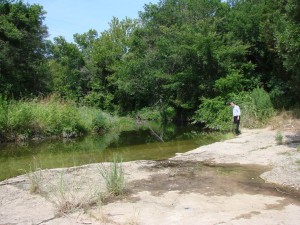
Background:
In July of 2000, Alvis Delk was wandering through the Paluxy river, in Glen Rose, Texas, when he flipped over a slab of rock which contained a pristine fossil dinosaur track. These tracks are common in the area, and he took it home for a keepsake.
It sat in his living room for eight years.
Sadly, in 2007, he had a bad accident which left him hospitalized for quite some time. When he got home, he needed money to pay off his medical bills, and began to clean off the dinosaur track in hopes that he could perhaps fetch a few hundred dollars for it.
This is when he discovered that was also a fossil human footprint in the rock, still covered under dried clay.
This find has profound ramifications for the Creation/Evolution debate. Evolutionary scholars have admitted that if dinosaurs and humans lived together in the past, then this completely destroys the theory of evolution.
The slab was purchased by the Creation Evidence Museum of Glen Rose, Texas. It was photographed and documented by David Lines, and molded by Dough Harris, Daniel Elif, and myself.
This page is devoted to providing my own first-hand knowledge and information about the track, and to answer many of the common questions and objections.
Common criticisms:
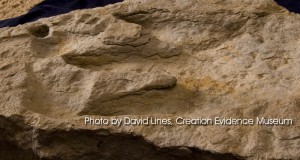 “It’s a carving”
“It’s a carving”
Hey – maybe! I’d just like to see some evidence of that, instead of this random ad-hoc claim being hurled around as if it were fact.
Unlike the skeptics, who make claims without one shred of evidence, I will actually present evidence as to why they are legitimate fossil footprints:
Friability of the rock:
Look at the photo yourself (close-up of matrix); I find it very difficult to believe that a rock this friable could be carved without disintegrating. This friability is quite common in the main track-bearing layer of the Paluxy.
Doug Harris and I spent an hour just claying up all those cracks before molding. We were gravely concerned that the silicone would literally rip the rock to shreds when we de-molded.
So how is one supposed to pound chisels into this rock, or run die grinders on it without shaking / hammering it into pieces?
Interestingly, I would also suggest this limits how far the slab could have been transported by the river. The Paluxy is well known to float slabs of rock the area of a car downstream, and this rock was obviously ripped up from its host rock and deposited where Delk found it. However, this rock simply could not sustain much tumbling – I doubt it went far.
CT scans show compression:
Of critical importance is the results of the CT scans that were performed on the slab. Watch the video at the top of this page to see an explanation of CT scans, how to read them, and see the scans for yourself. Also, head on over to David Line’s page which shows numerous cross-sectional X-rays produced by the CT scans.
These X-rays show distinct high-density areas in the rock immediately surrounding and underneath the tracks. Carving the tracks would have cut through the harder surface layer, and would be visible in the X-rays. Also, the typical claim of skeptics is that forgers in the past used acid to etch the rock after carving a dinosaur track, to hide the tool marks in the rock. Acid etching would actually reduce the surface density of the rock, and would be visible in the X-rays.
Furthermore, Dr. Carl Baugh (director of the Creation Evidence Museum) actually interviewed people who carved dinosaur tracks during the depression. These people tried carving human tracks once in a while (one must immediately wonder why they would do this – might I suggest it was because of the fossil human tracks they had seen in the Paluxy river bed which inspired them?), the human tracks never sold, and so they stopped carving them. Secondly, they never carved a dinosaur track and a human track together, for the simple reason that everybody immediately thought it was a fake and wouldn’t buy the track.
I am open to the objection / claim that it’s a carving, but so far, I haven’t even been remotely impressed by the calibre of skeptical arguments.
If anybody’s got any other ideas as to what it could be, besides a genuine fossil human footprint that a dinosaur stepped on, then I wanna hear it: email me at ianjuby at ianjuby.org
“That’s not an Acrocanthosaurus track”
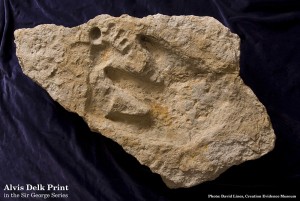 First of all, dinosaur track identification is tenuous at best. We were not there when the tracks were made, therefore dinosaur track identification is never anything more than a best guess – no matter who’s doing the guessing. You’re quite welcome to place your guess!
First of all, dinosaur track identification is tenuous at best. We were not there when the tracks were made, therefore dinosaur track identification is never anything more than a best guess – no matter who’s doing the guessing. You’re quite welcome to place your guess!
Originally the Delk dinosaur track was identified by Dr. Baugh as a Trachodon, specifically because there was no claw impressions. However, after comparing it side by side to other, actual fossil Acrocanthosaurus tracks in the museum, he concluded it was an Acrocanthosaurus track which simply had not pressed deep enough to leave claw marks.
There is the distinct possibility it could be the track from another dinosaur – I personally don’t care which one, because it’s a dinosaur track. Evidence of dinosaurs and humans living together completely destroys the concept of evolution, as leading evolutionary scholars have admitted.
 “Look how unnatural that human footprint is”
“Look how unnatural that human footprint is”
This is where it gets quite comical; because if it was a perfect track, the skeptics would say “it’s too perfect, it’s obviously a carving.” I know this because that’s what they’ve argued before with other human tracks from the Paluxy!
Human footprints take on a remarkable and strange variety of shapes and forms. If you don’t believe me, head down to the beach and examine footprints in sand, mud, clay, etc… You will be surprised. That footprint is completely human, there is no other creature that makes a footprint like a human. Even apes have, essentially, four “hands” – they don’t have “feet.”
In this case, it appears that the big toe got hooked during forward locomotion. Why would a carver carve a track in an “unnatural” position? It would be far more convincing if it were a “perfect” track, so why the imperfection? It makes more sense that it is a legitimate, albeit strange, track.
“It hasn’t been published in a reputable peer-reviewed journal”
Ah yes, this is quite a humorous argument too. No “reputable, peer-reviewed journal” dares to publish evidence like this which destroys evolution. Entire books have been written on this subject, not to mention the recent movie “Expelled: No Intelligence Allowed.” There are peer-reviewed creation journals out there, and this track will be included in our upcoming article on the Paluxy track research. However, evolutionists will simply reject such an article out of hand anyway, because it’s not an evolutionary journal.
Go figure – evolutionary journals won’t publish anything that knocks evolution, therefore because evidence like this won’t be published in evolutionary journals, it is rejected by evolutionists.
I’m not even going to waste much time with this very silly argument that has absolutely nothing to do with whether or not the tracks are authentic.
If there are some scientists who wish to legitimately examine it, I’m sure that can be arranged – but only under very strict control of CEM. Why? Because some evidence like this has been destroyed before. See Don Patton’s website for more details on this episode.
If there’s going to be a symposium / forum for interested investigators, I’ll post details here later.
“He’s not ‘Dr.’ Baugh – he faked his credentials”
Haha! First of all, I’m quite tired of this slanderous lie that’s been promulgated around the internet. I looked into it the whole matter myself – unlike the skeptics who just regurgitate a rumour they heard on talk.organs. Doctor Baugh worked very hard to earn his degree, and this has absolutely nothing to do with the authenticity of the Delk track…. does it?
It pleases me greatly to see such comments and railings, which are obviously nothing more than a desperate ploy to misdirect people from the evidence.
Look at the evidence people – it’s presented here, and ignore the babblings of those who would desperately try and distract you from it. In fact, you might want to ask yourself why they are so desperately trying to distract you from it! Look at the evidence, judge for yourself, and ask yourself what the ramifications are for you if the bible turns out to be true and evolution false.
“CT scans produce ‘beam hardening’ which accounts the higher density you see on surfaces”
(updated Aug 26, 2008)
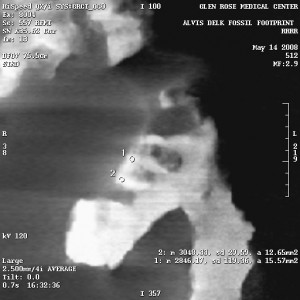 Okay, this is going to get a little technical on youse guys (“youse guys” – that’s Canadian for “Y’all”).
Okay, this is going to get a little technical on youse guys (“youse guys” – that’s Canadian for “Y’all”).
After much ado about “beam hardening” artifacts in the CT scans, combined with one comment posted on YouTube, I wanted to be sure about a few things. I called the Glen Rose Medical center and spoke with two separate CT technicians on a variety of issues surrounding the slab, including the technician who actually performed the CT scan on the Delk slab. It was very enlightening.
“Beam hardening” is an artifact in CT scan X-rays that appears at surfaces, including the surfaces of cavities. This was a problem in the early days of CT technology, as well as the early days of Gamma Ray CT. Because CT scans are compiled by computer, an algorithm can be incorporated into the analysis to remove beam hardening artifacts. While I’m not an expert on CT, everything I’ve been able to dig up so far shows that beam hardening artifacts never appear to go any deeper than 1-2 scan pixels below the surface.
Beam hardening is especially prominent with irregular surfaces, and the Delk slab would certainly fall under the category of “irregular surface.”
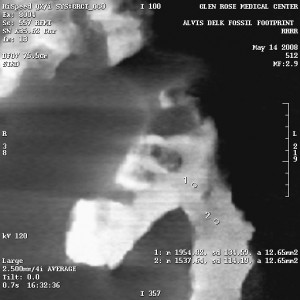 Could the higher density be from beam hardening and not from compression of the mud by the feet that made the prints?
Could the higher density be from beam hardening and not from compression of the mud by the feet that made the prints?
In short, it would appear “no way!”
As I had written here before, the high density is not visible around some of the cavities – like the outer toes of the dinosaur track. It is also completely absent from the heels of both tracks. As I argued then (and as the CT technician who performed the scan mentioned without my prompting), this “surficial beam hardening” would be visible on the entire rock, if it were from beam hardening.
Furthermore, the Glen Rose Medical Center’s CT scanner incorporates the anti-beam-hardening algorithms which removes beam hardening artifacts!
Can the very deep, high-density portions be explained by beam hardening or other artifacts?
There was a post on youtube by “ftom” that brought up some very good questions, but made a statement which must be addressed. He claimed 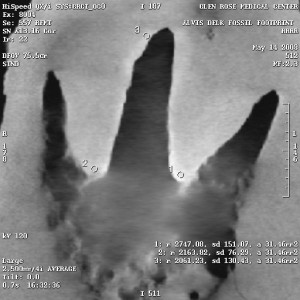 that 4cm deep “higher density” in the rock is not uncommon for beam hardening (at least, that was my understanding of what he said). I choked on this big time, but didn’t want to say anything until after I did some investigation, after all, maybe I’m wrong.
that 4cm deep “higher density” in the rock is not uncommon for beam hardening (at least, that was my understanding of what he said). I choked on this big time, but didn’t want to say anything until after I did some investigation, after all, maybe I’m wrong.
But think about it: Would you spend millions of dollars on a piece of equipment that’s supposed to be ultra-accurate if you can get false readings 4 centimeters deep and wide??!!??? I wouldn’t! Such false readings and beam hardening artifacts would complete invalidate the entire CT technology!
When I mentioned this to the CT techs, both of them remarked that this was flatly impossible. The second CT tech (who did notperform the scans) was looking at the scans on file at the time.
Furthermore, I will reiterate the facts which anyone can see by watching the video and looking at the full-resolution scans here and on David Lines’ website:
- the surface hardness is absent from many places in the rock
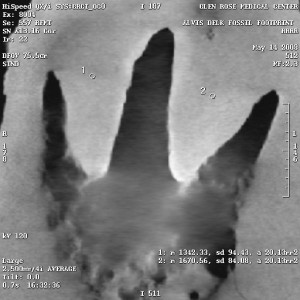 the highest density rock is at the junction of the middle dinosaur toe and the human footprint; where both tracks would have compressed the matrix. It is up to 4 centimeters deep and wide at this point (see below). This makes complete sense if the tracks are both authentic – both footprints compressed that area of mud. This makes no sense when trying to explain it as artifacts like beam hardening, as this is the only place where such large-area, high-density is visible.
the highest density rock is at the junction of the middle dinosaur toe and the human footprint; where both tracks would have compressed the matrix. It is up to 4 centimeters deep and wide at this point (see below). This makes complete sense if the tracks are both authentic – both footprints compressed that area of mud. This makes no sense when trying to explain it as artifacts like beam hardening, as this is the only place where such large-area, high-density is visible.- there are portions of the tracks which do not have any surficial hardening. Thus, it is clear that the higher density seen elsewhere is quite real. To claim that portions of the tracks show no higher density and thus must have been carved is a ludicrous argument: Did the carver only carveportions of the tracks? What about the portions that do show higher density and are therefore legit? No – thevariations in density only add to the authenticity of the density readings.
Are the density variations within a reasonable ratio?
There was “fall-out” from this post – click here to read the report.
Nevertheless, ftom made a very pertinent point about the density variations in the CT scans, and asked an excellent question: Are the density variations within reason? i.e., if the highest density was very hard, but the lowest density was that of a jellyfish, then there was a problem. I would agree, so I asked the CT techs to get a better handle on how density is calculated and portrayed on the scans.
As the CT technicians mentioned, they save people’s lives by scanning a tumour and diagnosing whether it is benign or malignant just by analysing the density variations!
It should be noted at this time that the images are also produced to maximize contrast. The X-rays you see have variable grey scales, and thus the pixel colour is not a true representation of the density, merely a guide – i.e., you can’t judge the density of a pixel by its shade.
The density variations are calculated using the Hounsfield numbers, and on the right are several select X-rays images from the CT scans, each of which has density sample sites. The circles are the sample areas, and the readings are in the bottom right corner of the image. For example, in Figure 7e, there are three sample sites, and the reading from sample 1 is listed as follows:
The only important things here are the first and last numbers. “m” is the hounsfield number, and “a” is the area of the sample circle.
To give you an idea of how to interpret the Hounsfield numbers, the higher the number, the higher the density. Hounsfield numbers have the density of water as their zero point.
The CT tech at GRMC very kindly gave me a smattering of sample numbers, so you have an idea of the density/hounsfield number ratio:
- Air inside a lung: -651 (note this is negative)
- Cortical bone: 172
- Liver: 33
- Rib center: 104
- Rib surface: 754
- Vertebrae: 195
So the lowest density sample in the Delk slab is a Hounsfield number of 487 (Figure 7e, sample 3), and the highest 3048 (Figure 7a, sample 2).
One thing can be said with certainty: the numbers are certainly of sufficient density – the lowest density is greater than that of most bone, except at bone surfaces like a rib, which is very hard, very dense, and very brittle.
The other conclusion which can be reached with certainty is that the density variations are real, and thus it is good evidence of compression of the mud matrix by two footprints, before the mud turned into rock.
“Dinosaurs don’t make tracks like that”
Um… yes, they do! Honest!
Q&A
“Are those drill holes making a line up the middle dinosaur toe?”
Nope. That’s actually the deepest part of the track, which happens to break through laminations in the rock in places, as well as some dimples in the rock, giving the appearance of a line of holes. See photo on right. The toes on the human track also break through laminations, leaving similar, circular holes in the rock.
“You mentioned ‘unintuitive compression’ in the video – what do you mean by this?”
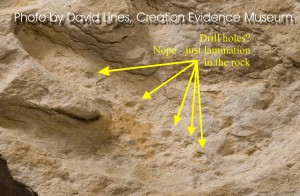 Particularly when Dr. Baugh sectioned dinosaur tracks from the Paluxy a number of years ago, it was noticed that sometimes there was no visible deformation underneath the track. There was no doubt about the authenticity of these tracks, so what was going on? Furthermore, Professor M.E. Clark (University of Illinois at Champaign/Urbana) who is a Paluxy track veteran of a few decades, also noted the lack of visible compression artifacts underneath a dinosaur track that had been broken in half when a ledge on the side of the Paluxy had broken off, revealing the cross-section of the track.
Particularly when Dr. Baugh sectioned dinosaur tracks from the Paluxy a number of years ago, it was noticed that sometimes there was no visible deformation underneath the track. There was no doubt about the authenticity of these tracks, so what was going on? Furthermore, Professor M.E. Clark (University of Illinois at Champaign/Urbana) who is a Paluxy track veteran of a few decades, also noted the lack of visible compression artifacts underneath a dinosaur track that had been broken in half when a ledge on the side of the Paluxy had broken off, revealing the cross-section of the track.
The Loma Linda university research report also sectioned a dinosaur track and a human track, both reported to have come from the Paluxy. They cited the lack of distortion underneath the dinosaur track as evidence it was carved. Sure – maybe it is a carved track – but the lack of distortion of the laminations underneath a track is not definitive of a carving.
However, the presence of laminations distorted by the foot when making the track is obvious evidence of authenticity.
When the Burdic man track was first sectioned across the ball, it showed no apparent distortion of the laminations in the rock – however, sectioning towards the heel and toes revealed incredible and dramatic distortion of the laminations. See Don Patton’s report here to see the distorted laminations yourself.
“There appears to be a thin layer of higher-density rock on all edges of the slab – care to comment?”
There does appear to be higher density patches on the edges of the slab, though it is also absent from patches along the edges as well.
Again, this is probably crystalization over time. We do not know when this rock was ripped up from its host, we don’t know how long it sat in the river, and we don’t know how long it sat on shore. Thus, the idea that it is surface hardening/crystalization over time seems a reasonable explanation.
Please note however, that this does not invalidate the higher density associated with the two tracks in any way:
1) Both tracks have areas (particularly the heels) where there is no higher density rock
2) The density variations associated with the tracks are dramatically deeper and wider than any of the surficial high density – by a factor of up to 3. In particular, the displaced mud at the intersection of the human track and the middle dinosaur toe was first compressed by the human, then displaced by the dinosaur. This high-density area is over 4 centimeters deep and wide, whereas the surficial high-density layer seldom exceeds 1.5 centimeters.
The dramatic variations in the density lend much credence to their authenticity. The variations appear to be quite real, and align well with the ichnofossils being genuine.
“What if someone carved the rock, and then etched it with acid?”
To answer this deep question, one of our researchers, David Lines, took some gen-you-whine Paluxy limestone – the very same stuff the dinosaur and human tracks are found in – and soaked it in muriatic acid. Read his very technical report here.
In short, acid wouldn’t affect the CT scans, although if it did, it would show up as a less dense surface.





Hello there! My name is Tiago and I am writing from Brazil!
Man, that Delk’s evidence is absolutely astonishing.
My mind blew up when I found it. I am a creationist. I neves bought the evolution idea because it always smelled fishy to me.
No wonder why I have never heard of this track. Thaley really want to avoid evolution’s defeat at all costs.
Anyways, thanks for the post.
God bless you!
Dear Mr. Juby,
Has anyone tried to replicate the Delk track in a similar medium, then fire it in a potters oven and subject the replica to C-14 scan?
Thanks,
Brent O’Conner
I was at the Paluxy River in 2000 (after a significant drought) and heard about the tracks (dinosaurs and humans together). My wife and I found them and videotaped them. At the time I thought this find would make big news but it didn’t. I just now looked online and found that apparently nobody has evidence (other human footprint tracks, etc.) that support the validity of this find. I do. I have video tape showing numerous tracks- (large) human and dinosaur. The paths cross each other (but are heading slighting in the same direction). There is no doubt in my mind that these are genuine human footprints and they are in the same layer of rock as the dinosaur prints. They were within a foot and a half or so of each other, although the tracks we found did not step one on another as Mr. Delk’s tracks do. I could easily show people where the tracks are located. (I assume they haven’t eroded yet.) And I have video of them. God’s Word is true.
You publish on YouTube. Please post the videos of the tracks.
Strat Goodhue, please post some of your evidence on youtube. I bet it will catch fire then.
I recently had the privilege of observing the Alvis Delk Track in person at the Creation Evidence Museum in Glen Rose, TX. After witnessing other human footprints in rock and also being part of an excavation uncovering new dinosaur footprints, and after considering all of the evidence, I have no reason to doubt the authenticity of the Alvis Delk prints, and I find this to be remarkable evidence in favour of the traditional doctrine of creation. -Dr. Kevin J. Mark